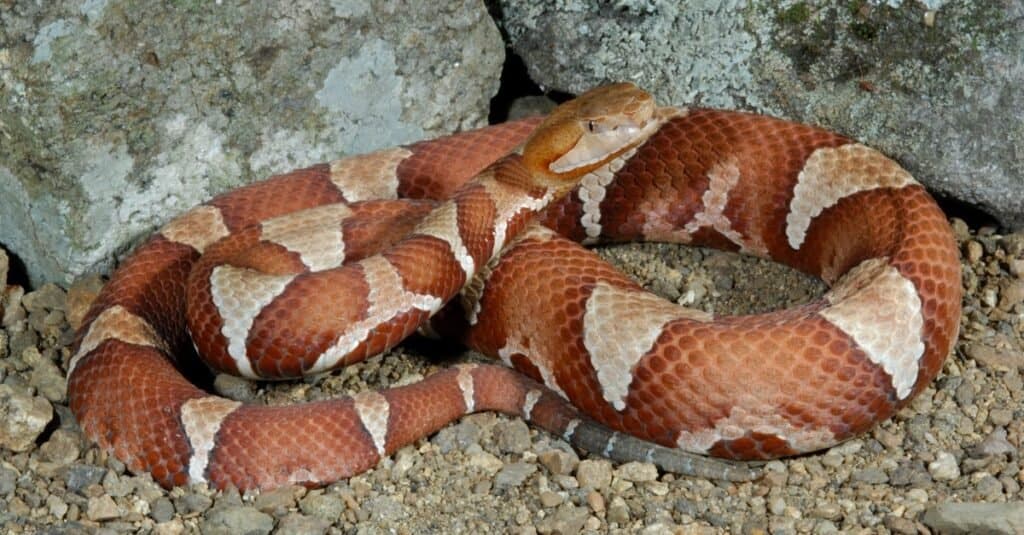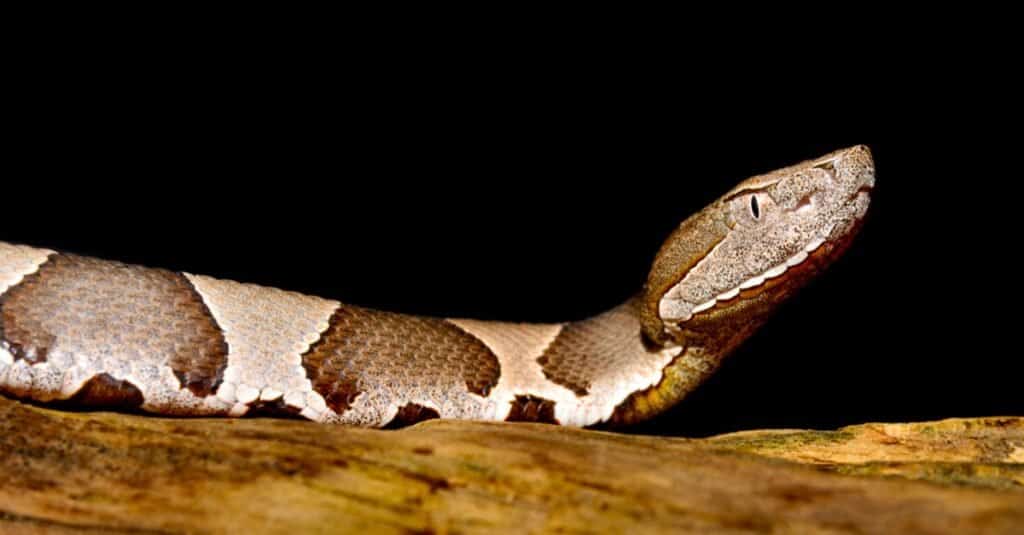Snakes are some of the most interesting animals in all of nature. Did you know there are venomous snakes living in almost every state in the United States? The copperhead snake is just one of many venomous snakes living in the U.S.
You may have heard of the copperhead snake, but could you pick one out of a lineup of venomous snakes? If the answer is no, then read on to learn what a copperhead snake looks like. Plus, discover where these snakes live, if they are aggressive, and why baby copperhead snakes have bright yellow tails.
What Does a Copperhead Snake Look Like?
This snake takes its name from its copper-colored head. An adult copperhead snake measures two to three feet long, but some grow to four feet.
A triangular head is one of the most notable things about a copperhead snake. It has a pit on each side of its snout. These pits are sometimes mistaken for the snake’s nostrils. But if you study a picture of this snake, you’ll see it has nostrils as well as heat-sensing loreal pits.
These pits allow a snake to sense the heat from warm-blooded animals nearby. In fact, its pits help it to determine the size of the warm-blooded animal — it allows them to strike accurately even in the dark. This is helpful when a copperhead is out hunting for prey, and because of these pits, copperheads are known as pit vipers.
In addition to using its pits to find prey, a copperhead snake uses its tongue. This snake flicks its tongue in and out of its mouth to pick up odors of warm-blooded prey in the vicinity.

©Breck P. Kent/Shutterstock.com
What Do Copperhead Snake Eyes Look Like?
The eyes of a copperhead help to identify it as a venomous snake. This snake has yellow eyes with black, vertical pupils. Copperhead snakes have excellent vision. Their eyes adjust to the darkness at night, helping them to find their prey. Their pupils work in a way that’s very similar to a cat’s pupils.
What Type of Scale Pattern Does a Copperhead Snake Display?
Another way to identify a copperhead is to look at its pattern. But keep your distance! The pattern of this snake features tan and dark brown markings. Each marking takes the shape of an hourglass. This hourglass shape disappears when it reaches the snake’s belly. These hourglasses are turned sideways and run down the length of the reptile, often giving the impression of chocolate kisses.
This pattern of two alternating colors and the hourglass or chocolate kiss pattern sometimes look similar to other snakes. This is why people mistake other types of snakes for copperheads. If you’re not sure what to look for, it can be easy to think that a non-venomous snake is a copperhead.
What Snakes Are Often Mistaken for Copperhead Snakes?
A corn snake has a pattern similar to a copperhead snake. It has alternating colors, but a corn snake’s scales are red or orange and tan. Plus, a corn snake doesn’t have a triangular-shaped head.
The appearance of a northern water snake can be mistaken for the appearance of a copperhead snake. Northern water snakes have a pattern that alternates light and dark. Specifically, this snake has a gray and tan pattern of splotches running down its body. However, there are subtle differences that can help someone identify this snake. A northern water snake has round pupils and a slender head.
Eastern milk snakes are sometimes mistaken for copperhead snakes. Eastern milk snakes have a brown and tan pattern of splotches, like the copperhead snake. They can grow to be four feet long, which is another similarity they share with the copperhead snake. But milk snakes aren’t venomous. In addition, if you ever get a glimpse at the belly of an eastern milk snake, you’ll see it has a unique checkerboard pattern of light and dark scales. A copperhead snake has a solid beige or tan belly.
Juvenile black racer snakes can be mistaken for copperhead snakes. Juvenile black racer snakes are not solid black like adults. Instead, juveniles have brownish scales with a pattern similar to a copperhead snake’s. As a black racer snake gets older, the pattern fades, and its scales turn black.
Why Does a Juvenile Snake Have a Yellow Tail?
You can identify a juvenile copperhead snake by looking at its tail. Juveniles have bright yellow tails! This bright yellow-tipped tail is used by the snake to attract frogs or lizards. A frog, lizard, or other prey thinks the yellow tail is an insect or worm. When they grab the insect, the snake quickly turns to capture its prey. Think of the bright yellow tail on a baby copperhead snake as a baited hook on the end of a fishing line.
After shedding a few times, a baby copperhead snake’s yellow tail is replaced with an adult’s brown tail.
Where Do Copperhead Snakes Live?
Copperhead snakes live in the eastern and southern parts of the United States. They live in forests, woodlands, and on hillsides. These snakes are usually found near a body of water like a pond, lake, or stream.
Copperhead snakes are sometimes found living in suburban areas. For instance, a copperhead snake may live in an overgrown, wooded lot in a neighborhood with lots of new homes under construction.
Are Copperheads Venomous?
Yes, these are venomous snakes, and copperheads should be taken very seriously. However, a copperhead snake bite is rarely deadly to a human. But medical attention is needed to tend to this snake’s bite regardless if someone thinks it may have been a “dry bite.”
Copperheads will generally bite feet and legs because people step on them. So, it is always wise to wear sturdy shoes, boots, and long pants when walking or hiking in areas where copperheads may live. Also, be sure to watch what you pick up in the woods because there may be a camouflaged snake nearby!
The venom of a copperhead snake attacks the tissue in the body and causes pain as well as swelling.
Is the Copperhead Snake Aggressive?
No, these snakes aren’t aggressive. They stay out of sight a lot of the time. Their brown and tan coloration helps them blend into a woodland or rock-filled environment. So, even if a copperhead snake is out basking in the sun, a person walking in the area may not see it. If a copperhead snake sees a human, it is likely to freeze and wait until the person leaves or move away to seek cover.
Of course, there’s always the chance of getting bitten, especially if a snake feels cornered or threatened. Like many other types of snakes, copperhead snakes are known to give what’s called a ‘dry bite’ to a person or threatening animal. A dry bite doesn’t contain any venom. Instead, it serves as a warning to the threat to move away from the snake. By the way, just because a snake gives a dry bite doesn’t mean the bite is painless. Furthermore, it’s not always easy to tell whether a snake has been given a dry bite or one containing venom. That’s why it’s necessary to get medical treatment.
Many snake bites occur when a person is walking in a wooded area and accidentally steps on a snake. If a copperhead snake, or any other type of snake, bites in this situation, it is only doing so to protect itself from further harm. This is why it’s a good idea to wear sturdy shoes when walking in an area known for its snake population. Having tough, heavy shoes with thick soles can protect a person against this type of bite.

.
©Jeff W. Jarrett/Shutterstock.com
Do People Keep Copperhead Snakes as Pets?
Yes, some people keep them as pets. But it’s not recommended. Though they are usually gentle, they still have the potential to deliver a venomous bite. These snakes aren’t recommended to be kept as pets.
What Are the Benefits of Having a Copperhead Snake Nearby?
Someone with a ranch or large piece of property with woods or weedy areas may have some copperhead snakes living nearby. While the first reaction may be to get rid of these snakes, there are some benefits to allowing them to stay in the habitat.
These snakes capture and eat a lot of rodents and insects. Rodents and insects can cause damage to crops, gardens, and other plant life on a piece of property. Plus, these snakes consume animals that have ticks, so they are reducing the tick population as well.
As long as a property owner is aware of the presence of the copperhead snakes and takes caution when walking through the area, these reptiles can be useful in controlling the pest population.
Up Next:
- Meet the Smartest Snake in the World: King Cobras Are you smarter than a king cobra? These critters are both deadly and clever.
- King Snake The royalty of the snake world? Find out why you may want these snakes in your neighborhood.
- 10 of the Most Common (and Non-Venomous) Snakes in North Carolina
The photo featured at the top of this post is © Joe McDonald/Shutterstock.com
Discover the "Monster" Snake 5X Bigger than an Anaconda
Every day A-Z Animals sends out some of the most incredible facts in the world from our free newsletter. Want to discover the 10 most beautiful snakes in the world, a "snake island" where you're never more than 3 feet from danger, or a "monster" snake 5X larger than an anaconda? Then sign up right now and you'll start receiving our daily newsletter absolutely free.
Thank you for reading! Have some feedback for us? Contact the AZ Animals editorial team.







